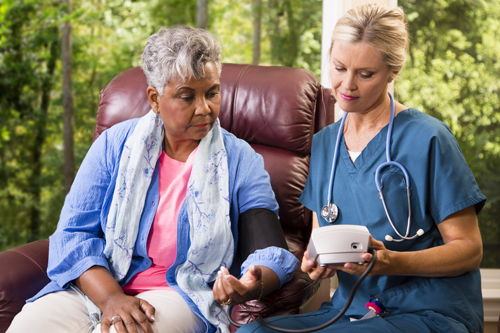What About Those New Blood Pressure Recommendations?

Hypertension (commonly called high blood pressure) means that the force of blood that pushes against the walls of our arteries is too high. Your healthcare provider measures your blood pressure with a special instrument, and records systolic pressure (your blood pressure during heartbeats) and your diastolic pressure (the pressure when your heart is resting between beats). The result is recorded as two numbers (for example, 120/80 — read as “120 over 80”).
You may have heard that the American Heart Association (AHA) and the American College of Cardiologists recently revised their evaluation of the numbers that are considered to be high blood pressure. During November 2017, they announced these new guidelines:
- Normal: Less than 120 systolic (top number) and 80 diastolic (bottom number)
- Elevated: Top number (systolic) between 120-129 and bottom number (diastolic) less than 80
- Stage 1 hypertension: Top number (systolic) between 130-139 or bottom number (diastolic) between 80-89
- Stage 2 hypertension: Top number (systolic) at least 140 or bottom number (diastolic) at least 90
- Hypertensive crisis: Top number over 180 and/or bottom number over 120, with patients needing prompt changes in medication if there are no other indications of problems, or immediate hospitalization if there are signs of organ damage.
Under these new guidelines, the number of Americans considered to have hypertension will grow from 32 percent to 46 percent. The AHA explains that this will help doctors address the potentially deadly condition at an earlier stage, to help patients lower their risk of heart attack, congestive heart failure, stroke, kidney failure, vision problems and other health conditions caused or worsened by hypertension.
What happened to “prehypertension”?
Why could your doctor diagnose “prehypertension” during one visit, and “stage 1 hypertension” during the next, even if your levels are the same? According to the AHA, the new guidelines eliminate the category formerly called “prehypertension,” which referred to readings of 120-139 systolic (top number) or 80-89 diastolic (bottom number). Sr. Paul K. Whelton, author of the guidelines, explains that our blood vessels begin to sustain damage as soon as our blood pressure begins to rise. Said Whelton, “You’ve already doubled your risk of cardiovascular complications compared to those with a normal level of blood pressure. We want to be straight with people — if you already have a doubling of risk, you need to know about it. It doesn’t mean you need medication, but it’s a yellow light that you need to be lowering your blood pressure, mainly with nondrug approaches.”
The new guidelines emphasize the proper measurement of blood pressure — and that includes home monitoring. You may have heard of “white coat hypertension,” when a person is so nervous at the doctor’s office that their blood pressure rises. The AHA tells us that people might also experience the opposite problem— “masked hypertension,” when a person’s blood pressure is lower in the healthcare setting than at home. Our blood pressure fluctuates, so frequent readings give a more accurate picture.
The AHA says the new guidelines don’t mean a substantial rise in people who will be prescribed blood pressure medication. They recommend prescribing medication for stage 1 hypertension only if a patient has suffered a heart attack or stroke, or if they have diabetes, kidney disease, or another health condition that puts them at high risk of a cardiovascular event. A patient’s age may also enter into the decision.
Many patients can lower their blood pressure into a safer range by increasing exercise and eating a healthier diet. In November 2017, researchers from Johns Hopkins Medicine noted that the heart-healthy DASH diet could be as effective as medication for many patients. This diet is low in sodium, sugar and unhealthy fats, and rich in fruits and vegetables, whole grains, fish, poultry, beans, seeds and nuts.
Bottom line: Be sure you know your blood pressure numbers. If yours fall into the “elevated” level or above, talk to your doctor about lifestyle changes that could lower it. If your doctor recommends medications, take them as recommended and have regular evaluations to determine how well the regimen is working. And be sure to report side effects, such as dizziness and dehydration, which can raise your risk of falls.
Source: IlluminAge AgeWise, reporting on news releases from the American Heart Association and Johns Hopkins Medicine. Visit the American Heart Association website to learn more about hypertension and how to manage it.
The information in this article is not meant to replace the advice of your healthcare provider. If you have questions about the new hypertension guidelines and your own blood pressure, talk to your doctor.
![Health Concepts [logo]](https://healthconceptsltd.com/wp-content/themes/healthconcepts-corporate/images/logo.png)
